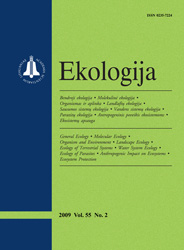 ISSN 0235-7224 ISSN 2029-0586 (online) |
2008 m. Nr. 2 Experimental research into the dispersion of railway traffic noise in the environment and its modelling
In recent decades, inadequacies between nature and human activities have become one of the most relevant social-economic problems. With the rapid development of industrialisation and urbanisation, the environmental pollution has greatly increased. In the majority of towns and settlements, noise is justly considered as an ecological problem. The Paneriai Railway Station was selected for the research as one of the most intensive by the number of passing trains. The analysis of the noise level caused by railway traffic near the junction of the Paneriai Railway Station shows that at low frequencies (31.5–250 Hz) the permissible noise level (PNL) was exceeded by 2–5 dB. The findings of research into noise caused by the passing railway transport show that the levels of the equivalent noise exceed by 4–8 dBA the noise levels permissible in living territories. The level of noise caused by passing trains is exceeded in the frequency range of 125–4000 Hz. The permissible noise level is exceeded by about 8 dB at the frequency of 500 Hz and 7 dB at the frequency of 1000 Hz. The generated model of noise dispersion from the railway traffic to the living environment helped offer the noise reduction walls as a means of improving the living environment. Keywords: railway traffi c noise, noise modelling, permissible noise level, noise reduction walls |
Issues:
2011 - Vol.57 No. 1, No. 2 2010 - Vol.56 No. 1-2, No. 3-4 2009 - Vol.55 No. 1, No. 2, No. 3-4 2008 - Vol.54 No. 1, No. 2, No. 3, No. 4 2007 - Vol.53 No. 1, No. 2, No. 2.priedas, No. 3, No. 4 2006 No. 1, No. 2, No. 3, No. 4 2005 No. 1, No. 2, No. 3, No. 4 2004 No. 1, No. 2, No. 3, No. 4 2003 No. 1, No. 2, No. 3, No. 4 2002 No. 1, No. 2, No. 3, No. 4 2001 No. 1, No. 2, No. 3, No. 4 |